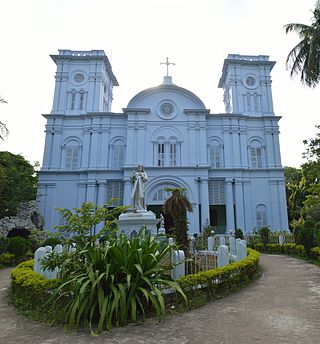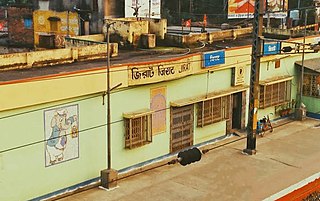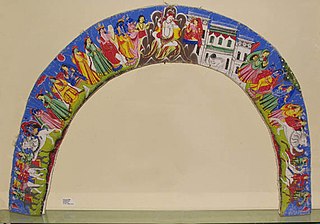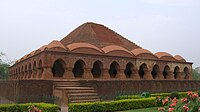
Shaktism is one of the several major Hindu denominations wherein the metaphysical reality, or the godhead, is considered metaphorically to be a woman.

Durga Puja, also known as Durgotsava or Sharodotsav, is an annual festival originating in the Indian subcontinent which reveres and pays homage to the Hindu goddess Durga, and is also celebrated because of Durga's victory over Mahishasura. It is particularly celebrated in the Eastern Indian states of West Bengal, Bihar, Jharkhand, eastern Uttar Pradesh, Assam, Odisha and by Hindus in Bangladesh. The festival is observed in the Indian calendar in the month of Ashvin, which corresponds to September–October in the Gregorian calendar. Durga Puja is a ten-day festival, of which the last five are of the most significance. The puja is performed in homes and public, the latter featuring a temporary stage and structural decorations. The festival is also marked by scripture recitations, performance arts, revelry, gift-giving, family visits, feasting, and public processions called a melā. Durga Puja is an important festival in the Shaktism tradition of Hinduism. Durga Puja in Kolkata has been inscribed on the intangible cultural heritage list of UNESCO in December 2021.

Dakshineswar Kali Temple or Dakshineswar Kalibari is a Hindu navaratna temple in Dakshineswar, Kolkata, West Bengal, India. Situated on the eastern bank of the Hooghly River, the presiding deity of the temple is Bhavatarini (Kali), a form of Mahadevi or Parashakti Adya Kali, otherwise known as Adishakti Kalika. The temple was built in 1855 by Rani Rashmoni, a Zamindar, philanthropist and a devotee of Kali Maa. The temple is known for its association with Ramakrishna and Ma Sarada Devi, mystics of 19th century Bengal.

Chandannagar, also known by its former names Chandernagore and Chandernagor, is a city in the Hooghly district in the Indian state of West Bengal. It is headquarter of the Chandannagore subdivision and part of the area covered by the Kolkata Metropolitan Development Authority (KMDA).

Jagatdhatri or Jagaddhatri is an aspect of the Hindu goddess Durga, worshipped in the Indian state of West Bengal and other states like Odisha and Jharkhand. Jagaddhatri Puja is particularly famous in Chandannagar town of Hooghly district,Krishnanagar of Nadia district and Ichhapur Nawabgunj of North 24 Parganas in West Bengal where it is celebrated as a five-day-long festival. Her worship and rituals are derived from Tantra. It is believed that her worship frees her devotees from ego and all other materialistic desires.

Belur Math is the headquarters of the Ramakrishna Math and Ramakrishna Mission, founded by Swami Vivekananda, the chief disciple of Ramakrishna Paramahamsa. It is located in Belur, West Bengal, India on the west bank of Hooghly River. Belur Math was established in January 1897, by Swami Vivekananda who was the disciple of Sri Ramakrishna. Swami Vivekananda returned back to India from Colombo with a small group of disciples and started work on the two one at Belur, and the others at Mayavati, Almora, Himalayas called the Advaita Ashrama. The temple is the heart of the Ramakrishna movement. It is notable for its architecture that fuses Hindu, Islamic, Buddhist, and Christian art and motifs as a symbol of unity of all religions. In 2003, Belur Math railway station was also inaugurated which is dedicated to Belur Math Temple.
Kolkata has many festivals throughout the year. The largest and most magnificently celebrated festival of the city is Durga Puja, and it features colourful pandals, decorative idols of Hindu goddess Durga and her family, lighting decorations and fireworks. Other major festivals are Diwali, Kali Puja, Holi, Saraswati Puja, Poush Parbon, Poila Boishakh, Christmas, Eid al-Fitr, Eid al-Adha, etc.

Domjur is a census town in Domjur CD Block of Howrah Sadar subdivision in Howrah district in the Indian state of West Bengal. It is a part of Kolkata Urban Agglomeration.It is famous for its gold jewellery industries.

The culture of West Bengal is an Indian culture which has its roots in Bengali literature, music, fine arts, drama and cinema. Different geographic regions of West Bengal have subtle as well as more pronounced variations between each other, with Darjeeling Himalayan hill region and Duars showing particularly different socio-cultural aspects.

Kali Puja, also known as Shyama Puja or Mahanisha Puja, is a festival originating from the Indian subcontinent, dedicated to the Hindu goddess Kali. It is celebrated on the new moon day of the Hindu calendar month of Ashwayuja or Kartika. The festival is especially popular in the region of West Bengal, and other places like Mithila and Anga of Bihar, Jharkhand, Odisha, Assam, and Tripura, as well as the town of Titwala in Maharashtra, along with the neighbouring country of Bangladesh.

Bengali Hindus are an ethnoreligious population who make up the majority in the Indian states of West Bengal, Tripura, Andaman and Nicobar Islands, Jharkhand, and Assam's Barak Valley region. In Bangladesh, they form the largest minority. They are adherents of Hinduism and are native to the Bengal region in the eastern part of the Indian subcontinent. Comprising about one-third of the global Bengali population, they are the second-largest ethnic group among Hindus after Hindustani Hindus. Bengali Hindus speak Bengali, which belongs to the Indo-Aryan language family and adhere to Shaktism or Vaishnavism of their native religion Hinduism with some regional deities. There are significant numbers of Bengali-speaking Hindus in different Indian states. According to the census in 1881, 12.81 per cent of Bengali Hindus belonged to the three upper castes while the rest belonged to the Shudra and Dalit castes.

Jirat is a census town located in Hooghly District in the Indian State of West Bengal. It is the administrative headquarter of Balagarh Block. It is birthplace of the Dr. Gangaprasad Mukherjee, Writer Charuchandra Banerjee, Tollywood actor Anil Chatterjee, sonnet writer Debendranath Senthe and poet Mohitlal Majumdar etc.

Madras Kali Bari is a Hindu temple located in the neighbourhood of West Mambalam in Chennai, India. Dedicated to the goddess Kali, the temple is constructed on the lines of the Dakhshineshwar Kali temple near Kolkata by the Bengali community in the city. Within the precincts of the temple, is a meditation hall where bhajans are sung daily. Bengali festivals like Durga Puja and Kali Puja are celebrated with grandeur.

The Hyderabad Kalibari is a Hindu temple located in the Vivekanandapuram, Neredmet neighbourhood of Hyderabad, 7 km from Secunderabad Railway Station, Telangana,India. The presiding deity of the temple is goddess Kali, hence the name Kalibari or Abode of Kali. The temple is famous for its Kali Puja and Durga Puja which is held on October/November of every year during Dusshera and Diwali.
Kurumgram is an old village located in Nalhati I CD Block in Rampurhat subdivision of Birbhum district in West Bengal State of India.

Chalchitra is a part of Bengal Patachitra. It referred to the Debi Chal or Durga chala, the background of the Durga Pratima or idol. Originally, these were used to give a proper proportion to the structure. This tradition is very ancient and is still maintained.

The Indian state, West Bengal has a rich cultural heritage. Due to the reign of many different rulers in the past, arts and crafts in West Bengal underwent many changes giving an artistic diversity today in the forms of traditional handicrafts, terracotta, painting and carving, dances and music.

Ahmedabad Kali Bari is a Hindu temple dedicated to Goddess Kali and the center for Bengali Culture in Ahmedabad, India. Established in 2014, it is situated on Kali Bari Road, West Ahmedabad.






















